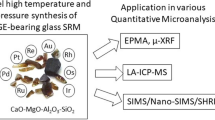Abstract
In the field of advanced ceramics two CRMs were developed in the last few years by the Federal Institute for Materials Research and Testing, one for silicon nitride and one for silicon carbide. Besides their application by industry they are appropriate to be used for the validation of special methods used for trace determination in accordance with high purity materials. This is demonstrated, for example, on ultrapure silicon carbide which was analysed by solid sampling electrothermal atomic absorption spectrometry (SS ET AAS).
BAM is also certifying primary pure reference materials used as the National Standards for inorganic analysis in Germany. The crucial point of this project is the certification of the total purity of high purity materials, each representing one element of the periodic table. A variety of different analytical methods was necessary to determine the trace contents of metallic and non-metallic impurities from almost the whole periodic table in the high purity materials. The primary CRMs of copper, iron and molybdenum are used as examples to demonstrate the modus operandi, analytical effects observed by using high resolution ICP mass spectrometry (HR ICP-MS) and the results.
Similar content being viewed by others
References
Friese K-Ch and Krivan V 1995Anal. Chem. 67 354
Kipphardt H 2004 Certification Report, BAM-Y001, BAM, Federal Institute for Materials Research and Testing
Kurfürst U 1998Solid sample analysis—Direct and slurry sampling using GF-AAS and ETV-ICP (Berlin, Heidelberg: Springer-Verlag)
Matschat R, Meyer K, Heinrich H-J and Scharf H 1999Advances in process measurements for the ceramic industry (eds) A Jillavenkatesa and G J Onoda (Westerville, Ohio: The American Ceramic Society) p. 107
Matschat R, Czerwensky M, Pattberg S and Heinrich H-J 2002Mater. Trans.—Jap. Inst. Metals 43 90
Matschat R, Czerwensky M, Traub H, Heinrich H-J and Kipphardt H 2003Matériaux & Techniques Nℴ Hors Série, December 2003, 37
Meyer K and Matschat R 2000 inReference materials in analytical chemistry (ed.) A Zschunke (Heidelberg: Springer Verlag) p. 57
Schäffer U and Krivan V 2001Fresenius J. Anal. Chem. 371 859
Author information
Authors and Affiliations
Corresponding author
Rights and permissions
About this article
Cite this article
Matschat, R., Heinrich, H.J., Czerwensky, M. et al. Multielement trace determination in high purity advanced ceramics and high purity metals. Bull Mater Sci 28, 361–366 (2005). https://doi.org/10.1007/BF02704250
Issue Date:
DOI: https://doi.org/10.1007/BF02704250




